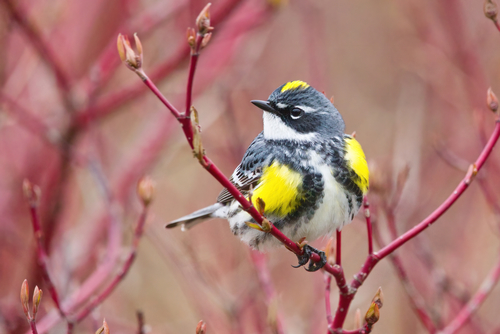
Yellow-rumped Warbler
The Yellow-rumped Warbler (Setophaga coronata) is a highly adaptable and widespread North American wood-warbler. It's known for its distinctive yellow rump patch, visible in all plumages, which gives it its common name. This species plays a crucial role in insect control within its varied habitats, consuming large quantities of insects, especially during the breeding season. Unlike many warblers that are strictly migratory, some populations of Yellow-rumped Warblers are resident or only short-distance migrants, allowing them to exploit resources year-round in certain areas. They are not particularly significant in human culture, but are appreciated by birdwatchers for their bright colors and active behavior.
12-15 cm
Length
19-24 cm
Wingspan
Least Concern
Conservation Status
Distribution
Breeds across much of North America, from Alaska and Canada south to the northern and western United States, and into parts of Mexico and Central America. Winters in the southern United States, Mexico, Central America, and the Caribbean. Migratory routes are extensive and varied, with some populations undertaking long-distance migrations.
Lifespan
Typically up to 7 years in the wild, though most live considerably shorter lives.
Yellow-rumped Warbler's Habitat
Habitat Types
Coniferous forests, Mixed woodlands, Deciduous forests, Open woodlands, Parks, Gardens, Coastal scrub
Climate Zones
Boreal, Temperate, Subtropical, Tropical
Adaptations
Adaptable to a wide range of habitats and elevations. Their ability to digest wax myrtle berries allows some populations to winter further north than most other warblers.
Variations
Two main groups are recognized: the 'Myrtle' Warbler (eastern) and the 'Audubon's' Warbler (western). These groups differ in throat color (white in Myrtle, yellow in Audubon's) and some other plumage details. They hybridize where their ranges overlap.
Appearance
Breeding Plumage
Breeding males are brightly colored with blue-gray upperparts, black breast streaks, and yellow patches on the crown, rump, and sides. Females and non-breeding males are duller, with brownish upperparts and less distinct markings.
Seasonal Feather Changes
Significant. Plumage becomes brighter and more contrasting during the breeding season.
Sex Based Plumage Differences
Yes, males are more brightly colored, especially during breeding season.
Notable Features
Yellow rump patch (present in all plumages), Yellow crown patch (more prominent in breeding plumage), White or yellow throat (depending on subspecies group), Black streaks on breast and sides (more prominent in breeding plumage)
Diet and Feeding
Primary Foods
Insects, Spiders, Berries, Seeds, Fruit
Foraging Behavior
Actively gleans insects from foliage, often hovering briefly. Will also flycatch, sallying out from a perch to catch insects in mid-air. Forages at all levels of vegetation, from the ground to the treetops.
Specializations
Can digest the waxy coating of bayberries and wax myrtle berries, allowing them to utilize a food source unavailable to many other warblers.
Seasonal Diet Variations
Primarily insects during the breeding season. In winter, diet shifts to include more berries and fruits, especially in areas where insects are scarce.
Behavior
Social Structure
Generally solitary or in pairs during the breeding season. Forms small flocks during migration and in winter, sometimes joining mixed-species foraging flocks.
Communication
Variety of calls, including a sharp 'check' call., Two main song types, one for each subspecies group., Songs are used for territorial defense and mate attraction.
Migration
Most populations are migratory, traveling between breeding grounds in North America and wintering grounds further south. Some populations are resident or short-distance migrants.
Territorial or Group Behaviors
Males defend territories during the breeding season. In winter, they are less territorial and may form loose flocks.
Conservation
Threats
Habitat loss and degradation (both breeding and wintering grounds), Pesticide use, Collisions with buildings and other structures, Climate change (potential impacts on habitat and food availability)
Protection Programs
Protected under the Migratory Bird Treaty Act in the US and Canada, Various habitat conservation initiatives
Local National Laws
Protected under various state and provincial wildlife laws.
Population Trend
Stable
Population Estimates
Global population estimated at 130,000,000.
Interesting Facts
They are one of the most abundant warblers in North America.
Their adaptability to a variety of habitats and food sources contributes to their large population size.
Their ability to digest wax myrtle berries allows them to winter further north than most other warblers.
This unique adaptation gives them access to a food source that is unavailable to many other insectivorous birds during the winter months.
The 'Myrtle' and 'Audubon's' forms were once considered separate species.
They were later lumped into a single species due to extensive hybridization where their ranges overlap.
Faqs about Yellow-rumped Warbler
What is the best way to attract Yellow-rumped Warblers to my yard?
Provide a variety of native plants that attract insects, offer a source of fresh water, and consider planting berry-producing shrubs like bayberry or wax myrtle.
How can I tell the difference between a male and female Yellow-rumped Warbler?
Males are more brightly colored, especially during the breeding season, with blue-gray upperparts and more black on the breast. Females are duller and browner.
Where do Yellow-rumped Warblers go in the winter?
Many migrate to the southern United States, Mexico, Central America, and the Caribbean. Some populations, particularly those that can eat wax myrtle berries, remain in more northern areas.
What should I do if a find an injured warbler
It's best to contact a local wildlife rehabilitator. They have the expertise and permits to care for injured wild birds. Avoid handling the bird excessively, and keep it in a dark, quiet place until you can get it to a rehabilitator. Consult a professional for medical or expert advice.
Copyright @ Nature Style Limited. All Rights Reserved.
 English
English